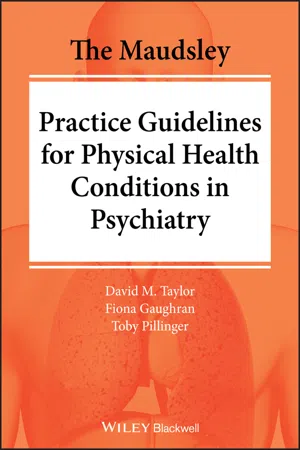
The Maudsley Practice Guidelines for Physical Health Conditions in Psychiatry
- English
- ePUB (mobile friendly)
- Available on iOS & Android
The Maudsley Practice Guidelines for Physical Health Conditions in Psychiatry
About this book
Learn to improve your assessment, investigation, and management of physical health conditions in people with severe mental illness
The Maudsley Practice Guidelines for Physical Health Conditions in Psychiatry offers psychiatric and general practitioners an evidence-based and practical guide for the appropriate assessment, investigation, and management of common physical health conditions seen in people with severe mental illness. Written by a renowned team of respected experts in medicine, surgery, pharmacy, dietetics, physiotherapy, and psychiatry, the book bridges the gap between psychiatric and physical health services for the severely mentally ill.
The Maudsley Practice Guidelines for Physical Health Conditions in Psychiatry also provides practitioners with expert guidance on making effective referrals to other medical and surgical subspecialties, telling readers what information subspecialties would expect to receive. Its use will improve the quality of clinical care received by mentally ill patients and, by promoting a holistic approach to treatment that considers both body and mind, will enhance the therapeutic relationship between patient and practitioner.
The Maudsley Practice Guidelines for Physical Health Conditions in Psychiatry covers the following:
- Guidance on assessment and management of well over a hundred different medical and surgical presentations commonly seen in people with serious mental illness
- Management of physical health emergencies in a psychiatric setting
- Evidence-based approaches to management of physical side effects of psychiatric medications
- Advice on approaches to promote a healthy lifestyle in people with serious mental illness, such as smoking cessation and changes to diet and physical activity
Perfect for both psychiatrists and general practitioners who wish to improve the quality of care they provide to people with serious mental illness, The Maudsley Practice Guidelines for Physical Health Conditions in Psychiatry will be of use to anyone setting out to navigate the divide between the treatment of psychiatric and physical health conditions.
Frequently asked questions
- Essential is ideal for learners and professionals who enjoy exploring a wide range of subjects. Access the Essential Library with 800,000+ trusted titles and best-sellers across business, personal growth, and the humanities. Includes unlimited reading time and Standard Read Aloud voice.
- Complete: Perfect for advanced learners and researchers needing full, unrestricted access. Unlock 1.4M+ books across hundreds of subjects, including academic and specialized titles. The Complete Plan also includes advanced features like Premium Read Aloud and Research Assistant.
Please note we cannot support devices running on iOS 13 and Android 7 or earlier. Learn more about using the app.
Information
Part 1
Cardiology
Chapter 1
Tachycardia
SINUS TACHYCARDIA
| Narrow QRS (≤120 ms) | Broad QRS (>120 ms) | |
|---|---|---|
| Regular | Sinus tachycardia Supraventricular tachycardia Atrioventricular re‐entrant tachycardia (AVRT) Atrioventricular nodal re‐entrant tachycardia (AVNRT) Atrial flutter (with regular atrioventricular block) Focal atrial tachycardia | Monomorphic ventricular tachycardia (VT) Any regular narrow‐complex tachycardia with aberrant conduction (e.g. bundle branch block/accessory pathway) |
| Irregular | Atrial fibrillation (AF) Atrial flutter with varying atrioventricular block Multifocal atrial tachycardia | Torsade de pointes Polymorphic VT Ventricular fibrillation AF with aberrant conduction (bundle branch block/accessory pathway) |
ATRIAL FIBRILLATION
SUPRAVENTRICULAR TACHYCARDIA
Table of contents
- Cover
- Table of Contents
- Title Page
- Copyright Page
- Preface
- Abbreviations
- Part 1: Cardiology
- Part 2: Endocrinology
- Part 3: Haematology
- Part 4: Gastroenterology
- Part 5: Renal and Urology
- Part 6: Sexual and Reproductive Health
- Part 7: Infectious Diseases
- Part 8: Respiratory
- Part 9: Neurology
- Part 10: Rheumatology and Musculoskeletal Health
- Part 11: Ophthalmology
- Part 12: Obstetrics and Gynaecology
- Part 13: Dermatology
- Part 14: Electroconvulsive Therapy
- Part 15: Emergencies
- Index
- End User License Agreement